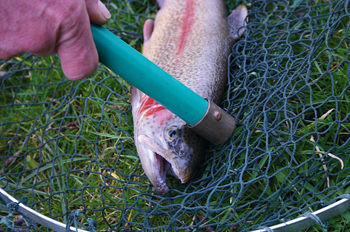Regular readers will know that I am something of a pot-hunter. In these days when catch-and-release is in vogue, it is perhaps not fashionable to admit to liking taking one for the pot, but actually no fish tastes quite as good as one you have caught and killed for yourself.
There is a lot of advice out there for those who wish to release fish, on how to handle them to minimise harm. Sadly, judging by the messy assassination attempts we see on the river-bank, the same is not true of clean despatch.
So, what follows is based on three principles: first, that one “tap” should do the trick; second, that the fish should suffer minimum distress between landing and death; and, third, that the carcass should be undamaged in terms of edibility. To do this well you need a decent priest, and most of the ones you can buy are just fine. My late father’s, which you see in the picture below, is made from an 18cm length of 2cm-diameter dowelling coated in shrink tube. It has about 3cm of brass tube riveted over the business end, so though it is far from heavy it does have the weight in the right place. It’s also a handy implement for despatching gamebirds.
When you land the fish, leave it in the net and lower it on to the bankside grass well away from the water. Do not try to hold it – your warm, dry hands will only cause it to struggle more. You should wait till it is dead to unhook, too. The fish will flap about, but if you wait a few seconds it will lie still. Give it a sharp rap on the top of its head, right between the eyes. You will know that you have done it right when the fish shivers and extends all of its fins for a few seconds before lying still.
Get the answers to all your country queries with a subscription to The Field.
Subscribe
today and never miss an issue.





